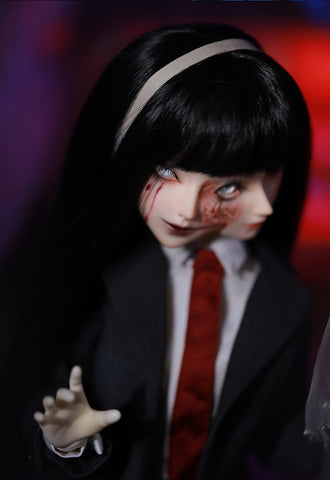Tomie junji doll from Edelweiss day
I've often said that books terrify me more than movies because I can imagine much worse than what a movie will show me (most of the movies that really get under my skin are things like The Haunting, 1963, where you don't see anything). I can frighten myself more than a movie ever could with good writing and descriptions... Junji Ito seems to exist just to hear statements like that, asking angrily, "You can imagine worse than I can show you?" Then, she gave me a Kubrick-like look before saying, "Challenge accepted." He then draws the most horrifying images; unadulterated, top-notch nightmare fuel. Even though it is still a book, Ito manages to frighten me without the help of my imagination.
I read the enormous Tomie omnibus that was published by Viz. It is a big hardcover that is about the same size as a Stephen King or fantasy book. To put it another way, you run the risk of crushing the digit rather than bruising it if you drop it on your toe (I'm sure Ito would relish the thought of that). However, considering that Ito wrote to Tomie on occasion between 1987 and 2000, this makes sense. The first two stories are also not nearly as polished, so you can tell it started early in his career. In these two, the art is very basic, the story isn't as strong, and some of the sequencing is a little bit confusing.
First things first: the book as a whole is uneven. Some of the stories are much more successful than others. Characters appear to be important, and they may even be for a few chapters, but they are then ignored. Plotlines change over time, and if you look at the most recent chapters and the storyline, you might be forgiven for wondering how we got here.
Having said that, Tomie's unevenness almost works to my advantage. We get to see a little bit of Ito's personal history, not because it makes the story better. We get to witness his overall development as an artist because he began working on this so early in his career and played with it for 13 years. When you read this book as a whole, You'll see Ito develop as an artist, you'll see him improve his control over the pacing and narration, and you'll learn how to make you absolutely dread turning the pages.
Some of the underlying themes are not the pacing but rather the more problematic nature of Tomie. Tomie... is something I cannot describe. A mix of succubus and resentment spirit; She is capable of seducing any man she meets to the point where they will either kill her for her or, as is frequently the case, kill her for them. The fact that I have no idea what Ito is trying to convey with this makes it seem like an issue. Honestly, one of the creepiest aspects of the book is how EVERY man, regardless of age, wants Tomie. On the other hand, I have the impression that it is a critique of masculinity and how Japan can fetishize school girls. On the other hand, it also feels borderline misogynistic that Tomie, who is regarded by many as the ideal representation of femininity, only ends up destroying the lives of those around her. I wouldn't be lying if I said that there are arguments presented on both sides in different chapters—indeed, sometimes even in the same chapter—and that it occasionally makes me feel uneasy.
I'll say it again: "it made me uncomfortable." Even though I can criticize or, at the very least, point to this aspect and ask questions about it (without providing an answer, I should add), I also have to admit that the only point may be that it makes the reader feel uncomfortable. In its own way, it makes reading more uncomfortable overall. It's problematic, just as horror in general is always problematic when thoroughly examined. It is the most progressive as well as the most regressive of all genres (punishment for anything considered outside of the traditional idea of proper behavior, but a genre in which a woman typically defeats a psychotic male wielding a phallic symbol by outsmarting him; yes, horror tropes are frequently very conflicted as a whole on what kind of message they want to send).
Is Tomie a work of art? No. Tomie is a unique kind of oddity, but Uzumaki will almost certainly be remembered as Ito's masterpiece. Its pacing is off and on, and while some chapters aren't very good, the ones that are are terrifying. Despite the fact that Ito has since gone on to create many more nightmares for us, this is a fascinating and, yes, terrifying work because it lasts long enough to see him learn his craft. Any horror fan should read it. 4/5 stars.
Additionally, before I leave, allow me to leave you with one final frightening image due to, well, ITO!

